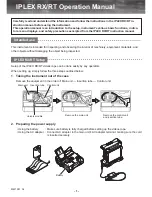
8
Avoid and Eliminate Condensation
Condensation can cause inaccurate results, and may damage the instrument. Generally condensation forms
when the sample, or the instrument itself is brought from a colder location into a moist and warmer one. All
must be allowed to come to ambient temperature. Condensation on tubes must be wiped away until the
tube sides remain dry. Never allow condensate or any liquids to enter the sample tube well. If this should
happen, take immediate action -- see Maintenance, Section 5.
Always Cap Tubes Before Testing
This seals the contents from contamination, and will prevent varying overhead light from entering the tube
during measurement. Wipe sides clean; hold tubes by cap.
Place the 942 on a Horizontal Flat Surface While Testing
Holding it by hand at an angle may disturb the sample and interfere by reflecting the light off the sample’s
meniscus (the curved surface of the liquid).
Orientation of Sample Tubes in the Tube Well
For reproducible test results when using a 975-TP Plastic Tube, align one of its 2 seams with the “6 o’clock”
position of the hole. No. 975-TG Glass Tubes do not have this requirement, and can be inserted without any
special orientation.
Reagent Tablets
Instructions are given whether the tablet is simply allowed to dissolve, or if it should be crushed with the
crusher/stirrer rod supplied. Always allow the tablet-treated test sample to stand for a few seconds so that
undissolved particles (if any) settle before test reading is taken.
Reagent Stability
For longest shelf life, unless otherwise specifically directed, store reagents in a dry, cool, and dark place.
Never insert a soiled pipet into a reagent bottle, and make certain to cap bottles tightly. Write the date of
receipt on reagent labels, and use previously received reagents first. Do not use liquid reagents beyond
their expiration date, if one is provided on the label. Accurate standard solutions may be used to check the
reliability of reagents of questionable age.
For Extremely Critical Work
Using a felt-tip pen, place a vertical alignment mark on the upper sides if the tubes (both blank and sample)
that you intend to use for such tests (but do not extend the lines into the photometric measuring portion of
the tubes). When inserting these tubes, rotate them so that the lines align with the white dot at the 6 o’clock
position of the tube bezel, so they will be identically and reproducibly positioned for each measurement.
Содержание 942-095
Страница 1: ...Series 942 The Mini Analyst Instruction Manual 942 095 Hardness Total Low Range...
Страница 23: ...23...









































